25 Émile-Jacques Ruhlmann Spindle-legged cabinet, model no. 1525AR 《心軸腿櫃子》 c. 1920s Macassar ebony-veneered wood, ivory, mahogany 112 x 30 x 29.4 cm. (44 1/8 x 11 3/4 x 11 5/8 in.) Executed in the 1920s.
Provenance Private Collection, France Literature Florence Camard, Jacques-Émile Ruhlmann, New York, 2011, pp. 415, 472 for a drawing and image of a similar example Catalogue Essay The fuseau cabinet and pedestal table offered in the present lots represent the moment in the early 1920s when Émile-Jacques Ruhlmann was solidifying his reputation as the preeminent modern designer. By the mid-twenties, after the monumental 1925 Paris exposition, Ruhlmann had achieved international renown for his sophisticated interior designs and luxurious furnishings. The recognition he received is a result of more than possessing a good eye or business acumen; it is due to his pursuit of holistic perfection in design and craftsmanship. As evidenced in the present lots, Ruhlmann combined an architectural approach with an unstinting commitment to artistry and worked with virtuoso craftsmen to create works that are the apotheosis of Art Deco style. From his earliest days, Ruhlmann had an intimate relationship with the built environment, and his affinity for architectural concerns extended into his furniture designs. Ruhlmann’s interest in an architectural approach to design can be seen in the fuseau, or spindle-leg, cabinet offered in the present lot. The sleek veneer delineates the discrete volumes that comprise the cabinet. The form is reinforced through the patterning of the Macassar ebony and the natural grain emphasizes the verticality of the architectonic composition. Additionally, the minimal ornamentation is unified with the overall form of the cabinet. The ivory accents are flush with the wood surfaces, emphasizing structural nuances rather than disrupting the purified form. The ivory dentil that crowns the cabinet further highlights the correspondence with architecture. Ruhlmann’s attention to the subtleties of volume and shape are likewise witnessed in the spindle legs, a hallmark of the designer. The attenuated appearance of the legs belies their complicated structure. Although they appear delicate and simple, the legs required labor-intensive construction and their attachment to the body of the cabinet provides structural support in the guise of elegant design. The work that Ruhlmann created in the early 1920s and displayed at the 1925 Paris exposition affirmed his status as master of modern design. For the exposition, Ruhlmann collaborated with over forty artists, designers, and craftsmen to realize his Hôtel du Collectionneur, an icon of Art Deco sophistication and style. It was one of the most popular and highly celebrated pavilions of the exposition (Jared Goss, “The Exposition Internationale ses Arts Décoratifs et Industriels Modernes and Ruhlmann’s Pavillion du Collection,” Ruhlmann: Genius of Art Deco, ed. Emmanuel Bréon and Rosalind Pepall, Paris and Montreal, 2004, p. 45). Photographs of the drawing room in the pavilion reveal a pedestal table very similar to the one offered in this sale. Following the exposition, demand for Ruhlmann’s designs increased substantially. He gained an international reputation through the touring of his work in America, including an exhibition at The Metropolitan Museum of Art in 1926 where the same pedestal coffee table was displayed once again. Evidently, it was a design Ruhlmann championed and was received enthusiastically as it is also recorded in photographs in Hotel Ruhlmann from 1923-24, Lord Rothermere’s Paris home around 1925, and in the decorating office of Ruhlmann himself. The present pedestal table and fuseau cabinet embody the design philosophy of Émile-Jacques Ruhlmann at the pivotal time in the designer’s career when his aesthetic crystallized and he achieved international esteem. Ruhlmann’s absolute commitment to form, artistry, and craft resulted in consummate examples of 1920s design that not only determined his success, but influenced the design of the era. Read More
25 Émile-Jacques Ruhlmann Spindle-legged cabinet, model no. 1525AR 《心軸腿櫃子》 c. 1920s Macassar ebony-veneered wood, ivory, mahogany 112 x 30 x 29.4 cm. (44 1/8 x 11 3/4 x 11 5/8 in.) Executed in the 1920s.
Provenance Private Collection, France Literature Florence Camard, Jacques-Émile Ruhlmann, New York, 2011, pp. 415, 472 for a drawing and image of a similar example Catalogue Essay The fuseau cabinet and pedestal table offered in the present lots represent the moment in the early 1920s when Émile-Jacques Ruhlmann was solidifying his reputation as the preeminent modern designer. By the mid-twenties, after the monumental 1925 Paris exposition, Ruhlmann had achieved international renown for his sophisticated interior designs and luxurious furnishings. The recognition he received is a result of more than possessing a good eye or business acumen; it is due to his pursuit of holistic perfection in design and craftsmanship. As evidenced in the present lots, Ruhlmann combined an architectural approach with an unstinting commitment to artistry and worked with virtuoso craftsmen to create works that are the apotheosis of Art Deco style. From his earliest days, Ruhlmann had an intimate relationship with the built environment, and his affinity for architectural concerns extended into his furniture designs. Ruhlmann’s interest in an architectural approach to design can be seen in the fuseau, or spindle-leg, cabinet offered in the present lot. The sleek veneer delineates the discrete volumes that comprise the cabinet. The form is reinforced through the patterning of the Macassar ebony and the natural grain emphasizes the verticality of the architectonic composition. Additionally, the minimal ornamentation is unified with the overall form of the cabinet. The ivory accents are flush with the wood surfaces, emphasizing structural nuances rather than disrupting the purified form. The ivory dentil that crowns the cabinet further highlights the correspondence with architecture. Ruhlmann’s attention to the subtleties of volume and shape are likewise witnessed in the spindle legs, a hallmark of the designer. The attenuated appearance of the legs belies their complicated structure. Although they appear delicate and simple, the legs required labor-intensive construction and their attachment to the body of the cabinet provides structural support in the guise of elegant design. The work that Ruhlmann created in the early 1920s and displayed at the 1925 Paris exposition affirmed his status as master of modern design. For the exposition, Ruhlmann collaborated with over forty artists, designers, and craftsmen to realize his Hôtel du Collectionneur, an icon of Art Deco sophistication and style. It was one of the most popular and highly celebrated pavilions of the exposition (Jared Goss, “The Exposition Internationale ses Arts Décoratifs et Industriels Modernes and Ruhlmann’s Pavillion du Collection,” Ruhlmann: Genius of Art Deco, ed. Emmanuel Bréon and Rosalind Pepall, Paris and Montreal, 2004, p. 45). Photographs of the drawing room in the pavilion reveal a pedestal table very similar to the one offered in this sale. Following the exposition, demand for Ruhlmann’s designs increased substantially. He gained an international reputation through the touring of his work in America, including an exhibition at The Metropolitan Museum of Art in 1926 where the same pedestal coffee table was displayed once again. Evidently, it was a design Ruhlmann championed and was received enthusiastically as it is also recorded in photographs in Hotel Ruhlmann from 1923-24, Lord Rothermere’s Paris home around 1925, and in the decorating office of Ruhlmann himself. The present pedestal table and fuseau cabinet embody the design philosophy of Émile-Jacques Ruhlmann at the pivotal time in the designer’s career when his aesthetic crystallized and he achieved international esteem. Ruhlmann’s absolute commitment to form, artistry, and craft resulted in consummate examples of 1920s design that not only determined his success, but influenced the design of the era. Read More
.jpg)

.jpg)
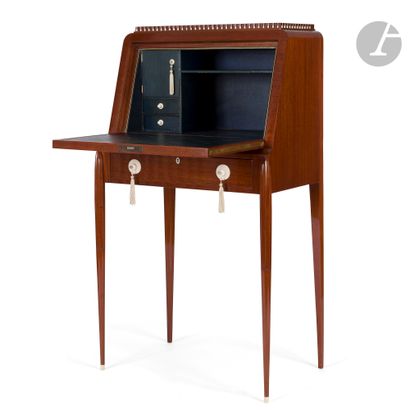
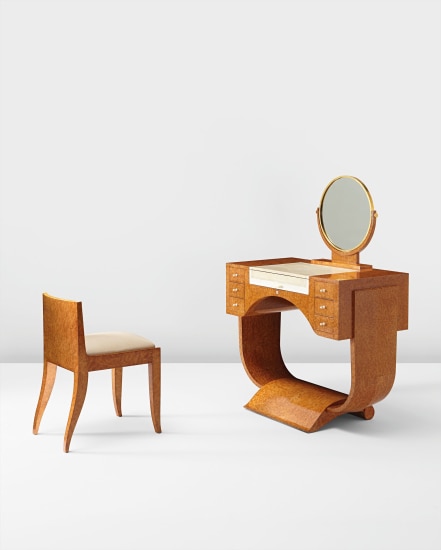
.jpg)

.jpg)

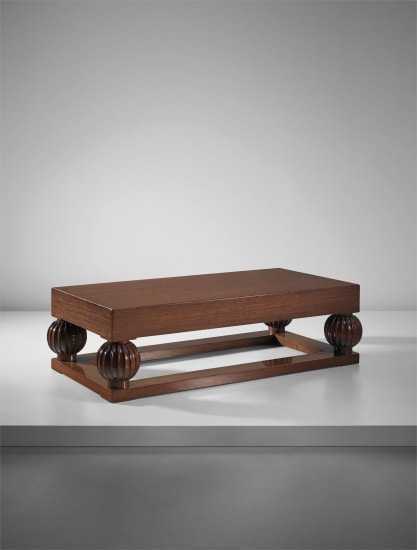
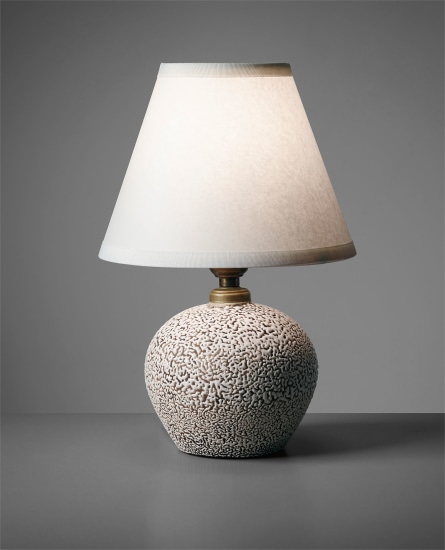
.jpg)
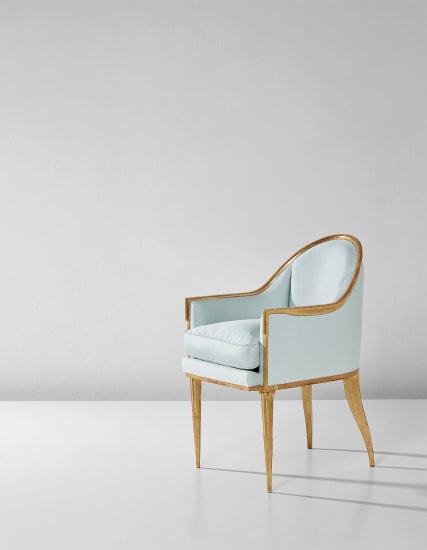
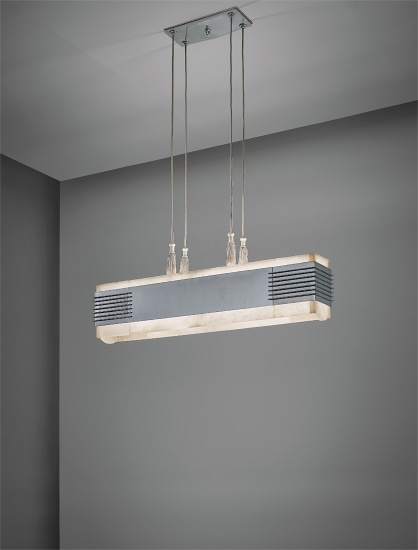
Try LotSearch and its premium features for 7 days - without any costs!
Be notified automatically about new items in upcoming auctions.
Create an alert